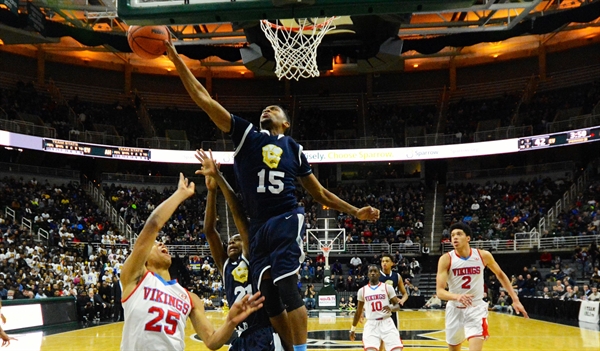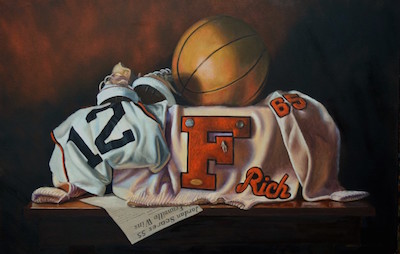
Arthur Hill Books Return Trip to Finals
March 27, 2015
By Geoff Kimmerly
Second Half editor
EAST LANSING – Saginaw Arthur Hill's run to this season's Class A championship game has been the result of strong on-court performances – but with a boost from a pair of behind-the-scenes conversations as well.
For the first meeting, coach Greg McMath invited all of his players except standouts Eric Davis and Brian Bowen, and told the other 10 how much more was needed from them for the Lumberjacks to contend for their third MHSAA title.
The second came during halftime of Friday’s Semifinal against Lansing Everett. Davis, a senior and this season’s Mr. Basketball runner-up, had scored 16 points to give Arthur Hill a three-point lead at the break. He told Bowen, arguably the top sophomore in the state, that the second half belonged to him.
Bowen scored 10 points over the final two quarters and four Lumberjacks scored at least 11 points total as they broke away for a 73-61 win over the Vikings at the Breslin Center.
“Coach said to go out there and have fun, and really there wasn’t too much to say,” said Davis, who will play next season at the University of Texas. “I talked to Brian, said big-time players make big-time plays. The first half was my half; this half will be your half. He’s the number one player in the country in my eyes, and I think he proved that in the second half.”
Arthur Hill will face top-ranked Detroit Western International in the noon Class A Final on Saturday. The No. 6 Lumberjacks (24-3) faced and fell to both this season, but have made significant strides over the last six weeks since suffering the last of their three defeats.
Davis finished with 20 points and six assists Friday and Bowen had 15 points, but they were matched by junior Billy Burton with 18 points and senior forward De’Quevion Johnson’s 11 points, nine rebounds and six assists.
 Johnson had nine of his points and Burton his final 11 during the second half.
Johnson had nine of his points and Burton his final 11 during the second half.
“If I was coaching against us, it would be to stop these two,” McMath said of Davis and Bowen. “I had a meeting with the other 10 guys on the team, with these guys not being there. I told them if we’re going to make a run and win a state championship, it’s going to be on you guys. (Davis and Bowen) get the press, and they deserve it. But that’s how much better we’ve gotten from the beginning of the season as a team.”
Everett led by at many as seven points while maintaining control for most of the first 13 minutes. But recalling disappointing third quarters in season-ending losses the last two seasons to rival Saginaw, McMath prepped his team this winter to make third-quarter runs.
The score Friday was last tied, 28-28, with 2:21 to go in the second quarter. From that point, Arthur Hill built a 13-point lead over the rest of the half and third quarter.
Eight points during that Lumberjacks run came on dunks as Arthur Hill sped up the pace and made extra passes to find open teammates cutting to the hoop. Ten of the team’s 16 fast-break points came during the second half.
“We did a poor job getting back on transition defense. On missed shots, sometimes we were going for too many steals in the backcourt, allowing dunks and not reacting on defense,” Everett coach Desmond Ferguson said. “It was a poor night for us defensively … and (defense) is what we hang our hat on.”
The No. 9 Vikings (24-3) can hang their hats on an improvement from 5-16 only a year ago. A sizable reason for the turnaround was the addition of senior center Trevor Manuel, who returned to Lansing after a year out of state and finished third in the Mr. Basketball voting. But three others scored in double figures Friday, and the strength of that supporting cast was as significant a reason behind this winter’s run.
The 6-foot-9 Manuel, who will continue at the University of Oregon, finished with 15 points and 16 rebounds. But junior guard Jamyrin Jackson was the team’s leading scorer with 16 points, senior guard Deshae Doll had 11 and junior guard Leandre Wright scored 10 and grabbed eight rebounds.
Click for the full box score and video from the press conference.
PHOTOS: (Top) Arthur Hill's’Willie Rodgers makes one of his three blocks during Friday’s Semifinal win over Lansing Everett. (Middle) The Lumberjacks’ Eric Davis works to get past Everett’s Leandre Wright.

Film Fills In Picture of 'Fennville Flash'
By
Ron Pesch
MHSAA historian
December 28, 2017
We’ve been here before, but not in this way.
The last time was for a retrospective, covering one of the most impressive and awe-inspiring prep careers in Michigan high school history. That time was in print, and included a handful of still images that tried to illustrate the unbelievable.
But this time, the story is in documentary form. It’s woven together from grainy, scratched, faded silent film, a format of capturing memories familiar to thousands of people from generations past, as well as a series of modern-day high-resolution interviews.
Here, the basketball life of the athlete known as the “Fennville Flash” delivers on many levels. Yes, there is a Richie Jordan.
JordanVille, a documentary by John Mooy & Anne Colton, recalls a time when legend spread via word of mouth, newsprint and AM radio.
While it’s hard to comprehend for many today, the exploits of our athletic heroes were formed by “poets in the press box” who sat with pencil and paper, a typewriter, a microphone or a telephone, and described to their audience what they witnessed. On the receiving end, readers and listeners conjured up visualizations based on the facts, phrases and superlatives designed to create an image.
“Traveling left to right on your radio dial” helped listeners feel they were a member of the crowd, seated in the stands, in on the action and a witness to the mayhem. “Packed to the rafters,” reminded fans the importance of what was happening. An exciting game, presented by those with skill, created an event you longed to see. If a broadcast couldn’t be picked up on a transistor or tube radio, the final result might not be known, at the earliest, until the following day’s newspaper arrived.
I’ve told Jordan’s story via the MHSAA before; how he latched on to athletic training, weights and repetition to mold himself into a well-rounded athlete, able to leap to heights unexpected for a kid with a 5-foot-7 frame. The tales of his unfathomable accomplishments slowly leaked beyond the city limits of Fennville into Kalamazoo and greater Southwestern Michigan, then to Detroit. When Detroit Free Press writer Hal Schram relayed Jordan’s feats, the secret traveled across the state and beyond its drawn borders.
From there the legend of Jordan’s accomplishments grew. In Fennville, as in many small towns across the country, the city shut down when a game was played. The Jordan story was so enticing that thousands would travel vast distances to see him play with their own eyes. Today, his single season scoring average of 44.4 points per game during the 1964-65 campaign still remains the top mark in the MHSAA record book.
 JordanVille runs just shy of a half hour. Contained within is insight into the athlete that is challenging to relay in print form. Thanks to access to home movies and a series of interviews with Jordan, former teammates, past opponents and his high school coach, the determination, dedication and drive of a kid who wouldn’t let physical size be a deterrent from achievement radiates from the screen. On display is small town America at its finest, and perspective formed over 50+ years.
JordanVille runs just shy of a half hour. Contained within is insight into the athlete that is challenging to relay in print form. Thanks to access to home movies and a series of interviews with Jordan, former teammates, past opponents and his high school coach, the determination, dedication and drive of a kid who wouldn’t let physical size be a deterrent from achievement radiates from the screen. On display is small town America at its finest, and perspective formed over 50+ years.
For Mooy, it completes a filmmaking journey started six years ago. But the story of Jordan, in his eyes, date back to his school days. Mooy first heard about Jordan as a 7th-grader from a math teacher. A second-team all-St. Joseph Valley League selection, Mooy played at Marcellus High School and scrimmaged against Jordan and the Fennville Blackhawks.
He couldn’t believe his eyes.
“Everyone wanted to see this kid play,” said Mooy in 2011. “He was the first high school player I saw sign an autograph.
Today, with the interviews complete, and the film ready for viewing, Mooy sees more than just a sports story:
“With the benefit of years now passed, I look at the Rich Jordan story with a new respect. JordanVille created a place that was welcoming no matter who you were, or what color your skin happened to be. It was the 1960s. Rich was growing up Jewish, the Civil Rights Movement was in full swing, and the Vietnam War was on everyone's mind. And in Fennville, Michigan, from 1961 to 1965, the Jordan high school years, there were lessons beyond sports being learned by everyone that would last a lifetime. The Jordan household, under the guidance of (his parents) Tuffy and Sylvia Jordan, is where the story begins."
The film speaks of a time that has departed. Competition for our attention was less focused; phones hung on walls or sat on tabletops, communities were tighter, the training table featured peanut butter and chocolate milk instead of protein powder. A city could easily be renamed for a day.
The film also reminds us that those days were far from perfect.
If all goes as planned, the public will see the finished product come the flip of the calendar. In West Michigan, JordanVille is scheduled to show on New Year’s Day at 6 p.m. on WGVU, and will repeat on WGVU-Life at 7:30 p.m., Friday, Jan. 5.
Seek it out, and spread the word, just like in days of old.
 Ron Pesch has taken an active role in researching the history of MHSAA events since 1985 and began writing for MHSAA Finals programs in 1986, adding additional features and "flashbacks" in 1992. He inherited the title of MHSAA historian from the late Dick Kishpaugh following the 1993-94 school year, and resides in Muskegon. Contact him at [email protected] with ideas for historical articles.
Ron Pesch has taken an active role in researching the history of MHSAA events since 1985 and began writing for MHSAA Finals programs in 1986, adding additional features and "flashbacks" in 1992. He inherited the title of MHSAA historian from the late Dick Kishpaugh following the 1993-94 school year, and resides in Muskegon. Contact him at [email protected] with ideas for historical articles.
PHOTOS: (Top) Richie Jordan runs Fennville's offense during his thrilling high school career in the 1960s. (Middle) Jordan memorabilia, as captured by Bill Williams.

